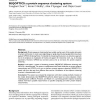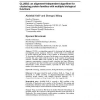172 search results - page 10 / 35 » ProtEST: protein multiple sequence alignments from expressed... |
NAR
1998
13 years 7 months ago
1998
The FSSP database and its new supplement, the Dali Domain Dictionary, present a continuously updated classification of all known 3D protein structures. The classification is deriv...
BMCBI
2007
13 years 7 months ago
2007
Background: By virtue of their shared ancestry, homologous sequences are similar in their structure and function. Consequently, multiple sequence alignments are routinely used to ...
BMCBI
2006
13 years 7 months ago
2006
Background: Protein sequence clustering has been widely used as a part of the analysis of protein structure and function. In most cases single linkage or graph-based clustering al...
IJCBDD
2008
13 years 7 months ago
2008
: CLUSS is an algorithm proposed for clustering both alignable and non-alignable protein sequences. However, CLUSS tends to be ineffective on protein datasets that include a large ...
BMCBI
2005
13 years 7 months ago
2005
Background: Whole-genome sequencing projects are rapidly producing an enormous number of new sequences. Consequently almost every family of proteins now contains hundreds of membe...


